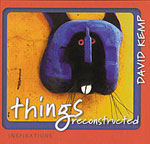Cornish Inspirations | |

| Last Saturday we actually
drove down to St Ives. ´So what?' you may think, and a couple of years ago I'd have agreed: we were always popping down there for the day, to see exhibitions and friends; after all, it's only a couple of hours away. But somewhere along the line I'd
forgotten about the place, and it had been over two years before this impromptu
visit. Besides the glorious late September sunshine, the Barbara Hepworth retrospective at the Tate St Ives, and several other shows in whitewashed galleries, not to mention the lovely meal we had overlooking the beach as the sun set; not to mention the realisation that Cornwall is really rather nice and quite near really, what I wanted to write about [yes, we're getting there] are some art books. One of them I picked up in the Tate bookshop: Things Reconstructed, a book about David Kemp. Kemp is a sculptor who makes things from what other people leave behind. Crazy, witty, ridiculous things. Plastic flowers for the Eden Project, ´King Coal' for a closed down coal mine, a giant jazz horn, several storeys high, for trendy Manchester. And he indulges in ´Future Archaeology', rebuilding things from what we discard, inventing the future inventing our past. Discarded wellington boots become mining hounds, scrap metal and plastic becomes masks or fiery chariots, fictional communication devices. Three or four years back, I had the pleasure of working with him for a few days at one of his installations-cum-exhibitions, and enjoyed getting to know him and his dog. I've seen several shows of his since the 1980s when I first saw some work of his in Stoke-on-Trent, and when I could have bought various postcards and handmade catalogues, but nothing has captured the sheer exuberance and eccentricity, the utter individuality, of the man and his work. Until now. Things Reconstructed is a 48 page hardback book that is part of an ´Inspirations' series published by Alison Hodge at ú9.95 per title. The series ´features the work of people who enrich our lives with their exceptional talent', or so the slightly precious blurb for the books says. Inside, the books are full colour throughout and very nicely designed. The Kemp book captures the variety and breadth of his work, featuring both small and large scale projects, as well as contextualising where and how the artist works. On one level the books are coffee table tomes, but I'd hesitate to call them that in case you are put off - they're much better than that term suggests. They are simple and interesting enough for children, but more detailed and informative than that might suggest too. Basically they're just good books; books as books should be. And I say books, plural, because I ordered a couple of other titles from the publisher's website when I got home, and they arrived two days later. Warm Frost features the work of the recently-departed Terry Frost, and again captures the energy and wide-range of work that Frost completed in his time. It also gives more of a chronology than the Kemp book, from Frost's first drawings in a prisoner of war camp through to his painted abstractions, rooted in the joy of colour and of the landcsape he inhabited. There are glimpses of his family and his studio, and groups of work under titles such as ´the sun', ´the moon', ´constructions and sculptures' as well as photos of ceramics, stained glass, and a plane livery for British Airways ! And endless informative and interesting quotes and statements from the artist himself. Again, it works for me on every level - the text and photos and design inform and complement each other perfectly. The earlier Coast which features the photographs of Bob Berry is a beautiful object, but the least succesful of the three for me. It's more a book of pictures than anything else, and I sometimes found the layering of photos over other photos distracting and annoying. I wanted more text, too: some statements, criticism and ideas. Perhaps some links to the photographic tradition or other artists who use the coast as their theme. But I quibble, it's just not quite as brilliant as the other two. The inspirations series has ´inspired and inspiring' as it's motto. So far they're telling the truth. I, for one, am going to keep an eye on what they publish next. In the meantime I recommend these three books to you. © 2003Rupert Loydell |